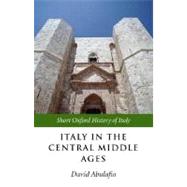
Note: Supplemental materials are not guaranteed with Rental or Used book purchases.
Purchase Benefits
What is included with this book?
| General Editor's Preface | v | ||||
| Acknowledgements | vii | ||||
| List of contributors | xiii | ||||
| Introduction: The many Italies of the Middle Ages | 1 | (26) | |||
|
|||||
| PART I RULERS AND SUBJECTS | |||||
|
27 | (31) | |||
|
|||||
|
27 | (2) | |||
|
29 | (6) | |||
|
35 | (7) | |||
|
42 | (6) | |||
|
48 | (8) | |||
|
56 | (2) | |||
|
58 | (24) | |||
|
|||||
|
59 | (3) | |||
|
62 | (1) | |||
|
63 | (1) | |||
|
64 | (2) | |||
|
66 | (2) | |||
|
68 | (1) | |||
|
69 | (1) | |||
|
70 | (1) | |||
|
71 | (1) | |||
|
72 | (1) | |||
|
73 | (2) | |||
|
75 | (1) | |||
|
76 | (3) | |||
|
79 | (1) | |||
|
80 | (2) | |||
|
82 | (22) | |||
|
|||||
|
82 | (4) | |||
|
86 | (3) | |||
|
89 | (2) | |||
|
91 | (2) | |||
|
93 | (2) | |||
|
95 | (3) | |||
|
98 | (2) | |||
|
100 | (2) | |||
|
102 | (1) | |||
|
102 | (2) | |||
|
104 | (23) | |||
|
|||||
|
109 | (2) | |||
|
111 | (3) | |||
|
114 | (5) | |||
|
119 | (2) | |||
|
121 | (6) | |||
| PART II SOCIAL CHANGE AND THE COMMERCIAL REVOLUTION | |||||
|
127 | (20) | |||
|
|||||
|
127 | (4) | |||
|
131 | (3) | |||
|
134 | (6) | |||
|
140 | (4) | |||
|
144 | (3) | |||
|
147 | (14) | |||
|
|||||
|
148 | (2) | |||
|
150 | (4) | |||
|
154 | (1) | |||
|
155 | (2) | |||
|
157 | (2) | |||
|
159 | (2) | |||
|
161 | (22) | |||
|
|||||
|
161 | (6) | |||
|
167 | (1) | |||
|
168 | (8) | |||
|
176 | (6) | |||
|
182 | (1) | |||
|
183 | (14) | |||
|
|||||
|
184 | (3) | |||
|
187 | (3) | |||
|
190 | (2) | |||
|
192 | (2) | |||
|
194 | (3) | |||
|
197 | ||||
|
|||||
|
197 | (2) | |||
|
199 | (2) | |||
|
201 | (3) | |||
|
204 | (3) | |||
|
207 | (8) | |||
| PART III THE OTHER FACES OF ITALY | |||||
|
215 | (22) | |||
|
|||||
|
217 | (1) | |||
|
222 | (1) | |||
|
228 | (1) | |||
|
236 | (1) | |||
|
237 | (14) | |||
|
|||||
|
238 | (1) | |||
|
241 | (1) | |||
|
243 | (1) | |||
|
244 | (1) | |||
|
245 | (1) | |||
|
248 | (3) | |||
|
251 | (4) | |||
|
|||||
| Further reading | 255 | (16) | |||
| Glossary | 271 | (4) | |||
| Chronology | 275 | (7) | |||
| Maps | 282 | (5) | |||
| Index | 287 |
The New copy of this book will include any supplemental materials advertised. Please check the title of the book to determine if it should include any access cards, study guides, lab manuals, CDs, etc.
The Used, Rental and eBook copies of this book are not guaranteed to include any supplemental materials. Typically, only the book itself is included. This is true even if the title states it includes any access cards, study guides, lab manuals, CDs, etc.